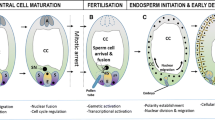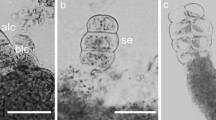Abstract
The process that leads to embryo formation appears to follow a defined pattern, whose sequential developmental steps—under strict genetic control—can be analysed through the study of mutants affecting embryogenesis. We present the analysis of four embryo-specific (emb) mutants of maize, characterised by abnormal development not overcoming the proembryo or early transition stage, that define three separate genes on the basis of their chromosomal location and complementation pattern. A common feature emerging from histological analysis is that suppression of morphogenesis is accompanied by an uncontrolled pattern of cell division. The block in embryo development is associated with abnormal suspensor proliferation, possibly due to the absence of a signal elaborated by the embryo proper and required for suspensor cell identity maintenance. Mutant endosperm morphogenesis is not impaired, as shown by the formation of the expected domains, i.e. aleurone, starchy endosperm, embryo-surrounding region and basal endosperm transfer layer. The program of cell death appears impaired in the mutants, as expected if this process is essential in determining the shape and morphology of the developing organs. An unexpected result is obtained when mutant embryo rescue is attempted. Immature embryos transferred to a basal medium germinated, yielding small but otherwise normal seedlings, an observation not consistent with the histological evidence of a complete absence of morphogenetic potential. The analysis of emb mutants appears a promising tool to elucidate crucial points of embryo development such as the coupling of cell division with morphogenesis, cell-to-cell interactions, the relationship between embryo and endosperm development, and the interaction between embryo proper and suspensor.





Similar content being viewed by others
References
Abbe EC, Stein OL (1954) The growth of shoot apex in maize: embryogeny. Am J Bot 41:285–293
Buckner B, Janick-Buckner D, Gray J, Johal GS (1998) Cell death mechanisms in maize. Trends Plant Sci 3:218–223
Buckner B, Johal GS, Janick-Buckner D (2000) Cell death in maize. Physiol Plant 108:231–239
Clark JK, Sheridan WF (1991) Isolation and characterization of 51 embryo-specific mutations of maize. Plant Cell 3:935–951
Despres B, Delseny M, Devic M (2001) Partial complementation of embryo defective mutations: a general strategy to elucidate gene function. Plant J 27:149–159
Dolfini S, Landoni M, Consonni G, Rascio N, Dalla Vecchia F, Gavazzi G (1999) The maize lilliputian mutation is responsible for disrupted morphogenesis and minute stature. Plant J 17:11–17
Elster R, Bommert P, Sheridan WF, Werr W (2000) Analysis of four embryo-specific mutants in Zea mays reveals that incomplete radial organization of the proembryo interferes with subsequent development. Dev Genes Evol 210:300–310
Gallois P (2001) Future of early embryogenesis in Arabidopsis thaliana. C R Acad Sci Paris 324:569–573
Giuliani C, Consonni G, Gavazzi G, Colombo M, Dolfini S (2002) Programmed cell death during embryogenesis in maize. Ann Bot 90:1–6
Green CE, Philips RL (1975) Plant regeneration from tissue cultures of maize. Crop Sci 15:417–421
Heckel T, Werner K, Sheridan WF, Dumas C, Rogowsky PM (1999) Novel phenotypes and developmental arrest in early embryo specific mutants of maize. Planta 210:1–8
Hobbie L, McGovern M, Hurwitz LR, Pierro A, Liu NY, Bandyopadhyay A, Estelle M (2000) The axr6 mutants of Arabidopsis thaliana define a gene involved in auxin response and early development. Development 127:23–32
Kaplan DR, Cooke TJ (1997) Fundamental concepts in the embryogenesis of dicotyledons: a morphological interpretation of embryo mutants. Plant Cell 9:1903–1913
Landoni M, Gavazzi G, Rascio N, Dalla Vecchia F, Consonni G, Dolfini S (2000) A maize mutant with an altered vascular pattern. Ann Bot 85:143–150
Meinke DW (1982) Embryo-lethal mutants of Arabidopsis thaliana: evidence for gametophytic expression of the mutant genes. Theor Appl Genet 63:381–386
Meinke DW (1995) Molecular genetics of plant embryogenesis. Annu Rev Plant Physiol 46:36–94
Meyer U, Torres Ruiz RA, Berleth T, Misera S, Jurgens G (1991) Mutations affecting body organization in the Arabidopsis embryo. Nature 353:402–407
Murashige T, Skoog F (1962) A revised medium for rapid growth and bioassays with tobacco tissue cultures. Physiol Plant 2:473–497
Pilu R, Consonni G, Busti E, MacCabe AP, Giulini A, Dolfini S, Gavazzi G (2002) Mutations in two independent loci lead to suppression of the shoot apical meristem in maize. Plant Physiol 128:502–511
Procissi A, Dolfini S, Ronchi A, Tonelli C (1997) Light-dependent spatial and temporal expression of pigment regulatory genes in developing maize seeds. Plant Cell 9:1–12
Satoh N, Hong SK, Nishimura A, Matsuoka M, Kitano H, Nagato Y (1999) Initiation of shoot apical meristem in rice: characterization of four SHOOTLESS genes. Development 126:3629–3636
Schwartz BW, Yeung EC, Meinke DW (1994) Disruption of morphogenesis and transformation of the suspensor in abnormal mutants of Arabidopsis. Development 120:3235–3245
Sheridan WF, Clark JK (1993) Mutational analysis of morphogenesis of the maize. Plant J 3:347–358
Songstad DD, Petersen WL, Armstrong CL (1992) Establishment of friable embryogenic (type II) callus from immature tassels of Zea mays L. Am J Bot 79:761-764
Souter M, Lindsey K (2000) Polarity and signalling in plant embryogenesis. J Exp Bot 51:971–983
Stiefel V, Lopez Becerra E, Roca R, Bastida M, Jahrmann T, Graziano E, Puigdomenech P (1999) TM20, a gene coding for a new class of transmembrane proteins expressed in the meristematic tissues of maize. J Biol Chem 274:27734–27739
Takada S, Hibara K, Ishida T, Tasaka M (2001) The CUP-SHAPED COTYLEDON1 gene of Arabidopsis regulates shoot apical meristem formation. Development 128:1127–1135
Vernon MD, Meinke DW (1994) Embryogenic transformation of the suspensor in twin, a polyembryonic mutant of Arabidopsis. Dev Biol 165:566–573
Vernon MD, Meinke DW (1995) Late embryo-defective mutants of Arabidopsis. Dev Genet 16:311–320
Yadegari R, De Pavia GR, Laux T, Koltunow AM, Apuya N, Zimmermann JL, Fischer RL, Harada JJ, Goldberg RB (1994) Cell differentiation and morphogenesis are uncoupled in Arabidopsis raspberry embryos. Plant Cell 5:1713–1729
Acknowledgements
This work was supported by EC-BIOTECH Grant No. BIO-CT96-0210 to G.G. and by a grant from Ministero Dell'Università e della Ricerca Scientifica e Tecnologica (Cofin - 2001) to G.C.
Author information
Authors and Affiliations
Corresponding author
Rights and permissions
About this article
Cite this article
Consonni, G., Aspesi, C., Barbante, A. et al. Analysis of four maize mutants arrested in early embryogenesis reveals an irregular pattern of cell division. Sex Plant Reprod 15, 281–290 (2003). https://doi.org/10.1007/s00497-003-0165-9
Received:
Accepted:
Published:
Issue Date:
DOI: https://doi.org/10.1007/s00497-003-0165-9




